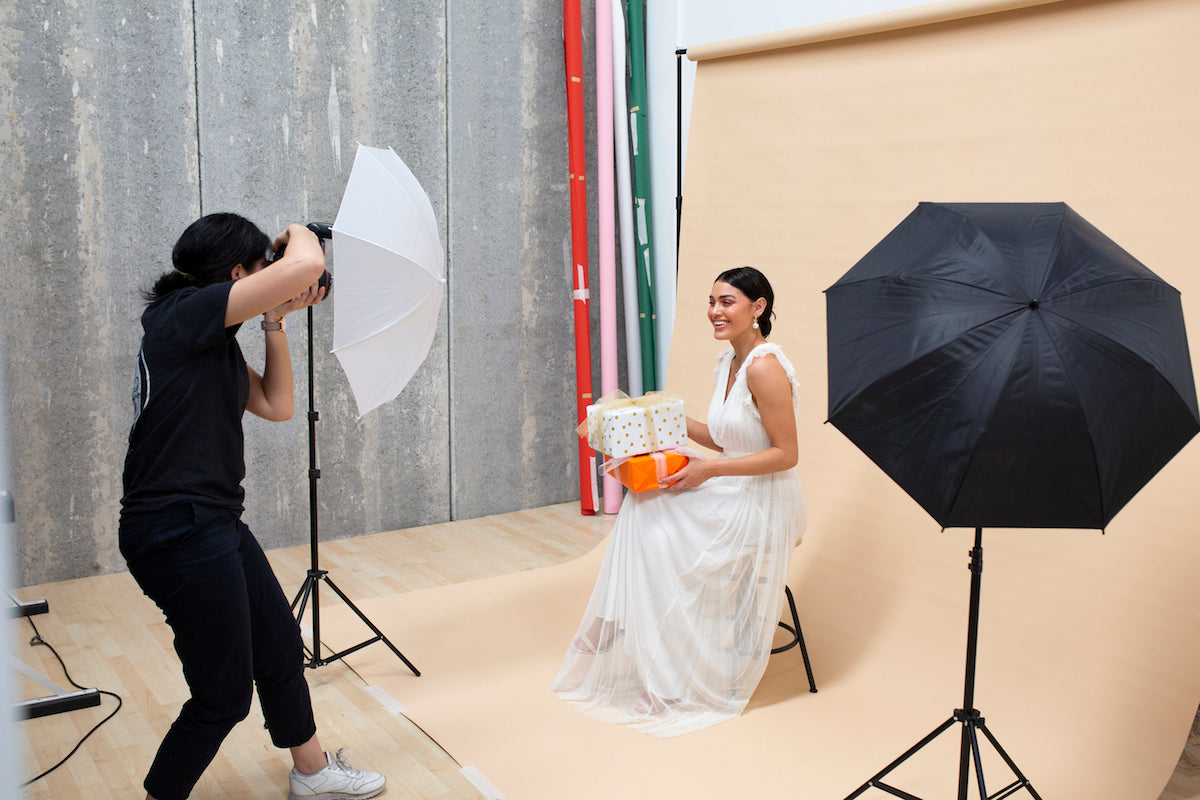
Are you a speedlight beginner? We all have to start somewhere, and our epic guide on how to use speedlight flashes will soon have you firing off your flashes like a pro! Speedlights are flashguns that attach to your camera’s hot shoe, but they can also be used as an off-camera flash and can be fired in groups - think of them as go-anywhere mini studio strobes.
We’re going to look at why and how to use speedlights - and we can promise you’ll never use your camera’s pop-up flash ever again!
What is the Purpose of a Speedlight Flash?

You may see these flashes called ‘speedlight’ or ‘speedlite’, depending on the brand, but they’re both essentially on-camera flashes that many photographers rely on. Why are they so good? There’s several reasons that photographers won’t go out without their trusty speedlight:
- Speedlights give you extra illumination when it becomes too dark to handhold your camera
- They give you more balanced exposures in daylight - you can shoot in strong sunlight without your subject becoming a silhouette
- You can freeze fast-moving subjects in a photo without blurring
- These lights can be used to control or trigger off other speedlights or strobes
- They can also be used for creative lighting effects
- You can add special flash modifiers like softboxes and umbrellas
- Speedlight flash can be ‘bounced’ off a white wall or ceiling to give you a much bigger, softer light source
What is a TTL Speedlight Flash?

TTL means ‘through the lens’, and to further confuse matters each speedlight brand tends to have a different name for their TTL mode (like E-TTL, iTTL, or P-TTL) but they all mean the same thing - your camera and flash talk to each other so that things like flash output brightness and distance are set automatically.
When you put your speedlight into TTL mode and press your shutter button halfway down, the speedlight puts out a ‘pre-flash’ of light. This is read by your camera’s metering system, and it calculates how much power your flash will need to put out to get proper exposure due to subject distance and the aperture you are shooting at.
One way to get the best out of TTL flash is to shoot with your camera in manual mode. The reason is because you will be scrambling your poor camera’s brain - if you are using one of the auto modes on your camera, then both systems are trying to find the correct exposure instead of just the speedlight. When both camera and speedlight are trying to determine correct exposure, you can never be sure whether your photo will be correctly exposed.

TTL works well when the distances between you and your subject keep changing, or if you aren’t great at guessing distances (like me!). TTL is great at parties and wedding receptions, where people are constantly moving around and you don’t have time to keep changing distance manually.
TTL flashes are also very good for beginners, as you don’t have to do calculations or dial in settings - the flash and camera will do it all for you. Many speedlight flashes are made to fit different camera brands, like the ones below:
- Godox TT350 2.4G TTL HSS Speedlite Flash for Camera (Available Models for Canon, Nikon, Olympus, Pentax, Sony, & Fujifilm)
- Godox TT685 2.4GHz E-TTL HSS Speedlite Flash (Available Models for Canon, Nikon, Olympus, Pentax, Sony, & Fujifilm)
-
Godox Ving V860IIC E-TTL HSS Master Speedlite Flash (Available Models for Canon, Nikon, Olympus, Pentax, Sony, & Fujifilm)
What is Manual Speedlite Flash?

This mode is more advanced, and you are the one controlling the flash output by entering the settings you decide on. You can also control flash intensity by moving the flash physically closer, or further away from, your subject. The closer the flash is to your subject, the stronger the light, and the opposite applies as you move the flash further away.
Manual flash is a good choice for shoots where nothing changes - like in a studio shoot where the distance to your subject doesn’t change from shot to shot and the ambient lighting conditions remain the same.
Most speedlights come with both TTL and manual flash modes, so you can switch from one to the other as you need. Some good speedlite choices are:
- Godox TT600 2.4G HSS Universal Wireless Camera Flash Speedlite (Compatible with Canon, Nikon, Olympus, Fujifilm, & Panasonic (EXCLUDING SONY cameras)
- Godox TT600S 2.4G HSS Wireless Camera Flash Speedlite for Sony (Same model as above but the only difference is the hotshoe pin configuration which is specifically made for Sony)
- Godox Ving V850II E-TTL HSS Master Speedlite Flash (Universal Flash, compatible with Canon, Nikon, Olympus, Pentax, Sony, & Fujifilm)
Speedlight Flash Terminology

There’s a lot of different terms relating to speedlights, so in this section we’re going to try and clear up any confusion!
What is High-Speed Sync?
In a nutshell, high-speed sync lets you sync your strobes to a camera when the shutter speed you choose is faster than 1/200th second. Normal flash sync speed is around 1/125 or 1/160th second, so if you want to shoot at higher shutter speeds with speedlights then you need to choose high-speed sync.
What is Recycle Time?
This is the time it takes for the flash to recharge after firing. It usually takes a few seconds for the flash to recycle, and that means you can’t use it during that time or your flash may not produce enough power to light your photos properly. Flashes usually indicate when they have recycled by beeping or a red light that goes on to show when they are ready. Flashes that feature a shorter recycle time mean you can shoot more often and won’t have to miss shots while you’re waiting.
What is a Guide Number?
The Guide Number (also called GN) shows the relative strength of your flash unit. Before automatic flash, you had to do math and measurements that involved the f/stop number you needed to use on a subject 10 feet away to get proper exposure. This was multiplied by 10 and ISO was set to 100. You don’t need to do all that, thankfully as the equation is simple - if your flash has a Guide Number of 14, say, then you would need to shoot at f/1.4 if your subject was 10 feet away.
So, the higher the Guide Number, the more powerful your flash unit is.
What is Rear Curtain Sync?
It’s a flash mode that is used to give creative effects like reverse motion blur. The shutter opens and closes for a certain length of time that’s decided by the shutter speed you set. When you choose Rear Curtain Sync, the flash fires at the end of the exposure (or the rear curtain) rather than earlier.
What is Flash Exposure Compensation?
Flash Exposure Compensation allows the photographer to add exposure compensation to increase or decrease the output power of their speedlights. Exposure compensation can be plus or minus in steps of ⅓ EV (exposure value).
Flash exposure compensation only affects flash output - your camera exposure settings aren’t affected. This means you can brighten darker areas of the image without overexposing brighter areas, which is handy if you have a lot of light areas and deep shadows in the same image. Exposure compensation is usually only found in auto or TTL flash modes.
What is Flash Duration?
It’s simply a measurement of how long it takes a flash to go from full power to off. Of course, it’s more complicated than that, but the times are measured from T.1 and T.5 results. T.5 measures the amount of time it takes your speedlight to go from off/full power/50% power. T.1 does the same, but measures down to 10% power.
Most manufacturers rate their speedlights only to T.5, but it’s the T.1 time that is important if you want to use your flash to freeze motion - you need a fast flash duration to do that. For most photographers the flash duration won’t matter so much, and if your subjects don’t move it won’t make a difference at all.
What is Master Flash/Mode?
If you are using more than one speedlight, the one that is on your camera is the Master Flash when set to that mode. It controls all the other flashes that are set to be slaves.
What is a Slave Flash/Mode?
Slave Flashes are off-camera speedlights that respond to the light from the speedlight set to Master that’s on your camera. Your camera doesn’t control them, so they don’t need to be connected to your camera, they just need to be able to detect the light from the Master Flash.
Speedlight Shapes (Round Head vs. Rectangle Head)

To add to the mix, speedlights come in different shapes and sizes! Godox recently released the Godox V1 Round Head Li-Ion I-TTL HSS Master Speedlight, but what’s the difference between rectangle and round head speedlights?
Well, it’s really simple - it’s the shape. If you’re using your speedlight inside a softbox modifier then it doesn’t matter what shape it is, but if you’re using other modifiers like umbrellas, then a circular shaped flash head will maximise the light from the circular umbrella. Circular speedlights also have a softer light falloff than rectangular ones.

Rectangular heads are designed to cover the same area as the camera frame when the flash is pointing directly at the subject and is on your camera. At the end of the day, the type of photography you do and the modifiers you use may sway your decision to use one shape or another.
How to Use Speedlights as an Off-Camera Flash

Using your speedlights off-camera gives you much more creative control over the lighting. You can use one or more speedlights off-camera to shape the direction and intensity of light produced.
It’s a great way of using speedlights to make stunning portraits, and is often used by wedding and fashion photographers. You can position the speedlights anywhere you like in relation to your subject instead of having your flash pointing straight at the subject, and this gives your portraits greater depth and dimension.
There are several things you need to make a successful off-camera flash setup:
- At least one wireless speedlight flash
- A wireless trigger and receiver set (depending on your camera and speedlight model)
- Ni-MH rechargeable batteries for speedlights and triggers
- Light stand with a speedlight mount
- Speedlight lighting modifier (like a softbox, umbrella, etc.)

The Godox Dual TT685 Complete Starter Speedlite Flash Lighting Kit has everything you need to complete your off-camera flash lighting setup. The kit includes:
- 2x Godox TT685 2.4G HSS TTl Speedlite Flash (Of Chosen Brand)
- 2 x Godox 80cm Octagon Reflective Umbrella Softbox (Portable) for Flash
- 2 x Godox S2 Speedlite Flash Bracket For Bowens / S-Type Mounts
- 2 x Hypop 180cm Photography Light Stand
- 1 x Godox X1T TTL HSS Single Transmitter Wireless Camera Flash Trigger (Of Chosen Brand)
- 1 x Hypop 120cm/48 inch Photography Studio Carry Bag

If you already have speedlights but want a set of modifiers, then check out the Standard Off Camera Flash (OCF) Double Umbrella with Tilt Mount Kit for Speedlites (Speedlite Excluded)
How to Use Speedlight Flash Modifiers

There are many times when a bare speedlight just won’t do the job - portraiture is one example. Flash modifiers give you more creative options and will soften and diffuse the harsh bare flash light to give you a more gentle, even spread of light. Other flash modifiers like snoots and honeycomb grids focus the light on a particular spot and give you a harder, more edgy light.
The Godox SA-K6 6-in-1 Universal Speedlite Accessories Kit for Flash contains everything you need to create different lighting looks:
- 6 different modifiers (Softbox, Colour Gels, Honeycomb Grid, Snoot, Reflector Diffuser,
- Flash Holder Type E-speedlite/umbrella bracket).
Another option is the Godox AK-R1 Accessory Kit. This kit includes a soft white diffuser dome, black snoot, colour gel kit, black honeycomb, barndoor with 4 flags, soft white diffuser plate, and curved bounce card. If you have a round head speedlight like the Godox V1, you can fit the modifiers directly, and if you have a rectangular head speedlight you can still use this kit with the handy Godox S-R1 Round Head Magnetic Modifier Adapter for Speedlites.
Conclusion

In case you’re still wondering if a TTL or manual flash is right for you, here’s a list of pros and cons for each one to help you choose:
TTL Flash Pros
- When the TTL speedlight is linked to your camera the flash power and zoom are automatically set - no need to dial in settings
- You can use TTL in auto, aperture priority, shutter priority, and scenic modes etc.
- TTL can also be used in manual camera mode
TTL Flash Cons
- They are much more expensive than manual flashes - can cost up to five times as much!
- TTL with off-camera flash on infra-red is notoriously unreliable - it’s affected by the sun and also line of sight.
- The results you get with TTL can vary and be difficult to repeat
Manual Flash Pros
- Much cheaper than TTL flashes
- You are the one in control of settings, not your flash or camera
- You learn to understand how light works and what settings to use much quicker than if you rely on TTL.
Manual Flash Cons
- You can’t use manual flash in any of the auto or semi-auto modes on your camera - only manual mode
- You have to calculate and set your flash power and zoom manually
Here’s a few final tips on getting the best out of your speedlights:
- Bounce your bare flash off a white ceiling or wall to give you a brighter and softer light if you don’t have a modifier
- Use your flash as fill light during daytime when your subject is backlit by the sun - it will light up the shadows on their faces and give an even lighting effect.
For even more speedlight know-how, check out our Best Godox Speedlights for Beginner Photographers blog post. You can get some really amazing lighting effects with speedlights, so it’s time to experiment. Most importantly - have fun learning what you can do!










